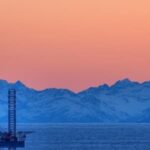CAMAC Energy Inc (ticker: CAK) is a Houston-headquartered oil and natural gas company exploring the vast onshore and offshore basins of East and West Africa. Offshore Nigeria, CAK currently produces from the Oyo Oilfield on block OML 120 with additional prospects on block OML 121. Production from Oyo generates cash for reinvestment in CAK’s other exploration and development programs offshore Nigeria, as well as Kenya and Gambia. Significantly, CAMAC believes there are deep Miocene prospects on Block OML 120; the deep Miocene is the zone from which most of the larger fields offshore Nigeria are produced, and CAMAC intends to test their deep Miocene prospects as part of its overall exploration portfolio. OAG360 notes that in a recent corporate presentation, CAMAC Energy has 3D seismic data over nearly 100% of OML 120 and OML 121. CAMAC Energy presented at EnerCom’s The Oil & Services Conference 11 on February 20, 2013. You can hear the webcast and see the presentation here.
CAK’s offshore Nigeria projects in the Oyo Oilfield are low-risk, high-reward properties that the company will continue to efficiently develop over time. Gross Oyo production during 2011 averaged 3,714 BOPD and 42 MMcf/d. OML 120 and 121 blocks are surrounded by Chevron (ticker: CVX), Shell (ticker: RDS.B), ExxonMobil (ticker:XOM) in an area with billions of barrels of recoverable oil. However, the real kicker in the story is CAK’s six high impact exploration blocks in Kenya and Gambia. This write-up will focus on current projects and the upside associated with Kenya and Gambia.
Targeting Traps Onshore Kenya
CAK announced it will conduct airborne gravity and magnetic geophysical surveys on its Kenya onshore Lamu Basin Blocks L1B and L16. The data acquisition will cover the entire 12,197 square kilometers in Block L1B and the entire 3,613 square kilometers in Block L16, exceeding the first exploration period’s gravity and magnetic survey requirements for each Block.
Why are airborne gravity and magnetic geophysical surveys important? CAK will use the gathered data to effectively target the placement of its 2D seismic shoots. The better placed the 2D seismic, the better opportunity to define structures, faults and volcanic layers on the blocks. Although the acquisition of G&G data may seem intuitive, OAG360 notes that CAMAC is one of only a few small cap E&P companies undertaking such surveys for their own account.
These types of airborne gravity and magnetic geophysical surveys are nothing new to Africa. Companies like Tullow (ticker: TLW), Heritage (ticker: HOIL), and Africa Oil (ticker: AOI) have used these shoots to identify target in the East African Rift basin for years. CAK expects to commence the gravity and magnetic geophysical shoot during Q2’13 and provide initial results during Q3’13.
Location, Location, Location
As you’ll see from the graphic below, CAK’s L1B and L16 blocks where they will be shooting seismic is in the heart of activity in Kenya. The street is awaiting results from Anadarko’s (ticker: APC) exploration wells in offshore Blocks L7, L11B, results from Ophir’s (ticker: OPHR) exploration well in Block L9, and results from Afren’s exploration well in transitional Blocks L17/L18. Newsflow from these operators should be robust in 2013.
Gambia Blocks A2 and A5: CAMAC’s emerging exploration play
On May 29, 2012, CAMAC Energy signed PSCs for two deepwater blocks offshore Gambia in which CAMAC has a 100% net interest and operatorship. The company plans to acquire 3D seismic over these blocks, which are immediately adjacent to, and landward of, African Petroleum’s Blocks A1 and A4.
Although there has only been one well drilled offshore Gambia by Chevron in 1979, there may be regional analogues in this area to Hyperdynamics’ (ticker: HDY) Guinea shelf oil shows from 2011 and Ophir’s Dome Flore and Sinapa Discoveries offshore Senegal and Guinea Bissau. The jury is definitely out on the Gambian offshore blocks, but the exploration potential in this area represents another possible West African offshore play in its nascent stages.
Final Thoughts on CAMAC Energy
It’s a busy time over CAMAC Energy. Near term catalysts that could have a meaningful impact on CAK’s position in its African exploration programs include the drilling of its Oyo #9 well which is expected to add an additional 7,000 BOPD gross, a high impact well targeting the Miocene in Nigeria, and results from its Kenya seismic shoot. As of September 30, 2012, CAMAC’s liquidity position stood at approximately $26 million, which includes $5.7 million cash and $21 million from an undrawn revolver. We’ll continue to follow CAK’s progress in Africa closely.
Important disclosures: The information provided herein is believed to be reliable; however, EnerCom, Inc. makes no representation or warranty as to its completeness or accuracy. EnerCom’s conclusions are based upon information gathered from sources deemed to be reliable. This note is not intended as an offer or solicitation for the purchase or sale of any security or financial instrument of any company mentioned in this note. This note was prepared for general circulation and does not provide investment recommendations specific to individual investors. All readers of the note must make their own investment decisions based upon their specific investment objectives and financial situation utilizing their own financial advisors as they deem necessary. Investors should consider a company’s entire financial and operational structure in making any investment decisions. Past performance of any company discussed in this note should not be taken as an indication or guarantee of future results. EnerCom is a multi-disciplined management consulting services firm that regularly intends to seek business, or currently may be undertaking business, with companies covered on Oil & Gas 360®, and thereby seeks to receive compensation from these companies for its services. In addition, EnerCom, or its principals or employees, may have an economic interest in any of these companies. As a result, readers of EnerCom’s Oil & Gas 360® should be aware that the firm may have a conflict of interest that could affect the objectivity of this note. The company or companies covered in this note did not review the note prior to publication.










